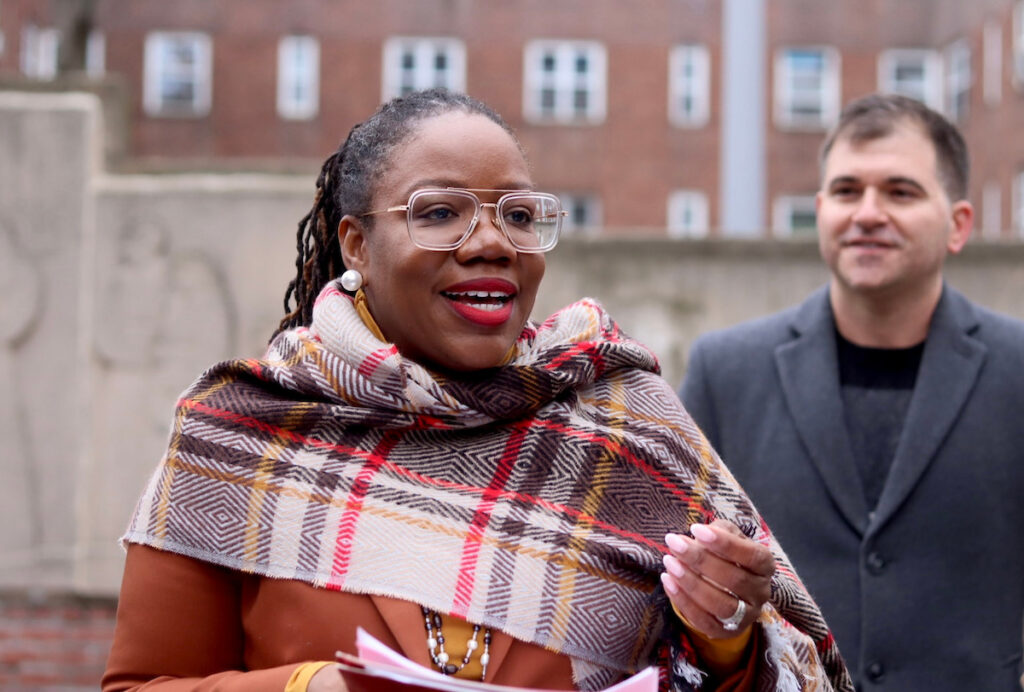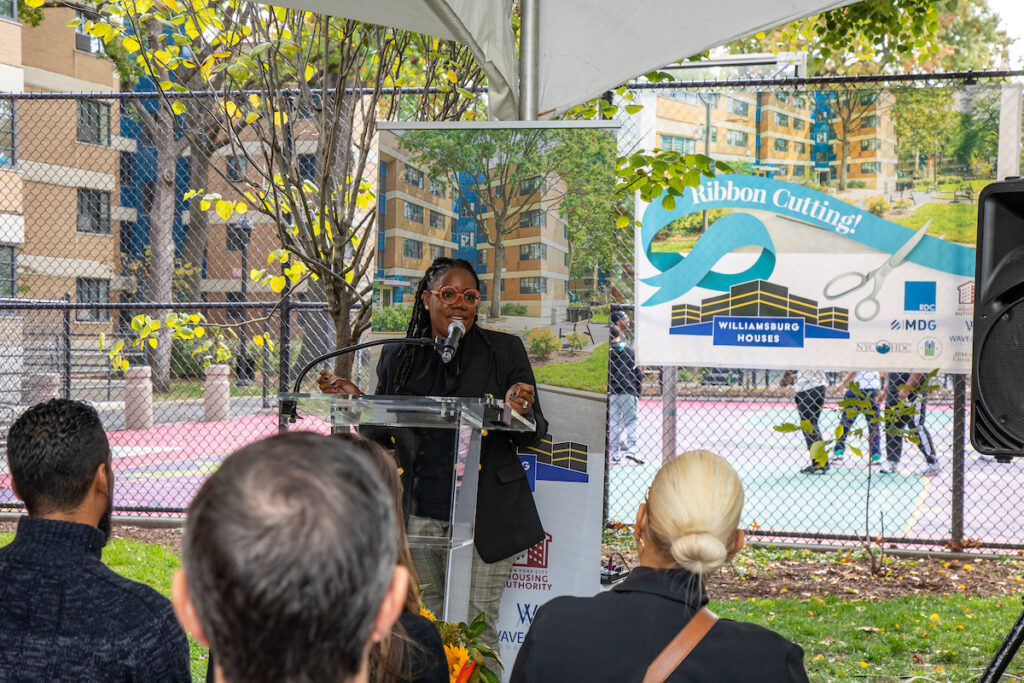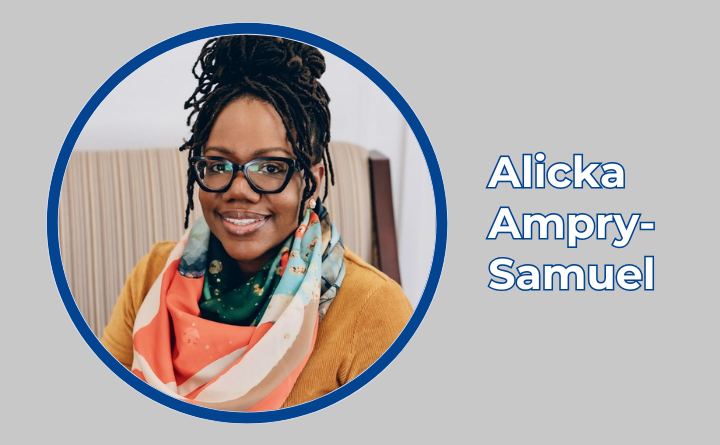Alicka Ampry-Samuel: Public Housing Advocacy and Leadership
Alicka Ampry-Samuel’s commitment to public housing runs deep: She grew up in NYCHA’s Marcus Garvey Houses in Brownsville, Brooklyn; is a former NYCHA employee; and has spent much of her career working with and advocating for NYCHA residents. She recently completed her appointment as the U.S. Department of Housing and Urban Development’s (HUD) Regional Administrator for New York and New Jersey. Her unwavering advocacy on behalf of NYCHA residents is a testament to how one of NYCHA’s own continues to champion for the improvement and preservation of public housing.
Appointed to HUD by President Joseph Biden in January 2022, Ms. Ampry-Samuel was responsible for ensuring HUD served local communities, including by managing housing assistance programs, directing resources to state and local governments, and more.
Prior to HUD, Ms. Ampry-Samuel served as the New York City Council Member for the 41st District — home to the highest concentration of public housing in North America — from January 2018 to December 2021. While on the City Council, Ms. Ampry-Samuel served as Chair of the Public Housing Committee, where she advocated for investment in public housing and worked to ensure residents’ voices were heard in policy decisions. Her leadership in the City Council laid the foundation for her subsequent appointment by President Biden to HUD.
Before embarking on her political career, Ms. Ampry-Samuel served in various roles, including as a Child Protective Specialist for the NYC Administration for Children’s Services; as a Democracy and Human Rights Coordinator at the U.S. Embassy in Accra, Ghana; and as Chief of Staff in the New York State Assembly to Latrice Walker. She also previously worked at NYCHA as Senior Advisor to the Executive Vice President for Community Engagement and Partnerships.
Her journey from growing up at Marcus Garvey Houses to becoming a leading advocate for public housing at the national level was a path of taking a role, seeing a problem, and then asking herself what more she could do. And her dedication to public service was instilled in her by her mother, who worked for the City of New York for 34 years, was an active union member, and served on her community board. Public service was what her family did, and public housing was central to her family’s growth.
The NYCHA Journal spoke to Ms. Ampry-Samuel about her time on the City Council, her role at HUD, and the proudest moments in her career.
During your time as a City Council Member, you represented District 41, which has the highest concentration of public housing in North America. How did this shape your approach to policy and constituent services?
I viewed constituent services as communication to my neighbors, friends, and family. Representing folks in public housing meant you had to be intentional about how you reach people. You want to ensure someone on the 20th floor at Langston Hughes knows we’re doing an open house, and you can’t just put a flyer between the elevators and on top of the mailboxes. There are some elected officials who were scared to knock on doors in public housing buildings; they preferred to door-knock at houses.
Growing up in the district is one of the reasons I ran for office. Other Council Members never came from Brownsville proper; none had been born and raised in the developments, so they didn’t have the lens I had that some problems could be fixed through support and resources.

While on the City Council you were vocal about the need to invest in public housing. What steps do you think are necessary to ensure the improvement and sustainability of public housing in NYC?
We’re in a real housing crisis. It’s public housing, affordable housing, and home ownership opportunities. We know that public housing is underfunded, but there’s a debate about what level it should be funded at. We need to be able to articulate the needs of public housing residents to those who write the budgets and pass funding. We have to encourage residents to share their stories and advocate for themselves without a third-party middle person who may not fully articulate their needs.
We also need to realize that public housing was built during a different moment in our history. Where we are today is not where we were when public housing was built, so we have to find ways to modernize policies, laws, and regulations to speak to what is needed today to trigger more funding, even when that means funding from the private sector or collaborating with other agencies. It’s a new day, and this is a pivotal moment for us to make new decisions to preserve public housing.

You’ve been a strong advocate for ensuring the voices of public housing residents are heard. How do you think governments can better engage residents?
Community engagement is key and how we should operate. For example, when grant funding is allocated to cities and states from the federal government, it often requires some level of community engagement. We have to continue down this line with residents being included in the formal process of deciding who is going to come into their communities in a meaningful way.
As HUD Regional Administrator, you oversaw a large region that includes New York and New Jersey, and both urban and suburban areas. How did this role deepen your knowledge and understanding of public and affordable housing?
At HUD, we worked as a federal family. I saw how you could work collectively across agencies to preserve public housing. Using Edenwald as an example, that development had major capital needs and its preservation was made possible by several agencies, including HUD and the U.S. National Park Service, all working together so we’re not putting the burden on the housing authority. It was about sitting down and working together to not just preserve one development, but one community collectively – because HUD is housing and urban development, it’s not just the people and buildings but everything that surrounds it as well.
In your time at HUD, what are some of the accomplishments you’re most proud of?
I’m proud of being able to connect community and stakeholders to HUD. I was able to connect MWBE developers with the agency providing them with access, because I’ve worked with so many of them during my time on the City Council and they helped develop thousands of units in my community. Those relationships will still exist after my time at the agency.
I’m proud I got the HUD Secretary to visit Brownsville and East New York twice. One of the meetings we had was a roundtable with 15 pastors to discuss the housing crisis, their experiences helping to build senior housing, and what HUD could do to help them continue to build and preserve affordable housing. This resulted in a working group focused on how faith-based institutions can work with HUD. We published a guidebook in June. That was my baby for three years; I’m so proud of it.
You’ve been recognized for your leadership in public housing, and City & State named you as one of the 100 most influential Black New Yorkers. What drives you to continue advocating for the most marginalized communities, and how do you stay so focused and motivated?
This is tough work and it’s sometimes difficult to stay motivated. My mother worked hard to get me to be the woman I am today. She told me to reach the highest educational opportunities I could attain and come back home and do something with it. I owe a debt to her, to my grandmother, and all those folks in Brownsville who got me to be who I am today. Though my mother isn’t here to have seen her little girl become a presidential appointee, that’s a seed she was able to sow. For me, legacy is not about seeing my name on a building or having a street named after me. I believe the seeds I plant today will eventually be trees with fruit that will allow for generations to be able to eat. I won’t see it, but my children and grandchildren will. I’m working for that; that’s what keeps me motivated.
Looking back at your career thus far, what is one of your proudest moments working on behalf of public housing?
One of my proudest moments was taking NYCHA residents to London to visit the housing authority there. At the time, London council housing was going through their own preservation process, so this was an opportunity for NYCHA residents to see other communities around the world facing the same issues.
Many of the residents who attended were part of Community Voices Heard, and they were able to keep the conversation going and advocate for themselves. They took what they experienced, and now we’re seeing some of the fruits of their labor with the [NYC Public Housing Preservation] Trust and the opportunity to be a true voice and make real decisions as we see play out during the new voting process. Residents are voting for change in a meaningful way. I’m proud to have had that experience with them. The impact for me was residents seeing and believing that they don’t only have a local and national voice but an international voice, too. Helping residents realize they are part of a larger, global conversation and community about housing and that they deserve better was invaluable.
What’s next for you?
I’ve lived a life of public service. My 26-year career has been about housing some of the most vulnerable in society. I don’t know what’s next, but I hope my next role will allow me to continue in this field and making a difference on behalf of the people.

